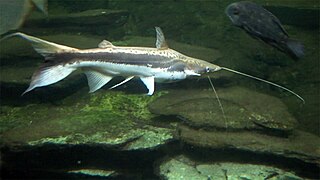
Pseudoplatystoma is a genus of several South American catfish species of family Pimelodidae. The species are known by a number of different common names. They typically inhabit major rivers where they prefer the main channels and tend to stay at maximum depth, but some species can also be seen in lakes, flooded forests, and other freshwater habitats. They have robust bodies, and are important food fish. Recently, their population size has been on the drastic decline due to a variety of factors including overfishing and habitat destruction due to the construction of hydroelectric dams.

The Pimelodidae, commonly known as the long-whiskered catfishes, are a family of catfishes.

Baryancistrus is a genus of freshwater Loricariid catfish. They inhabit flowing sections of rivers, especially clearwater, in the basins of the Amazon and Orinoco in Brazil and Venezuela. The largest species reach up to 34 cm (13 in) in total length.

Sorubim is a small genus of long-whiskered catfish native to tropical South America. A number of characteristics allows the differentiation of each species in the genus. Sorubim species are important food fish in South America and are highly significant to fisheries of some areas; however, harvests of these fish are not identified as much as other, more popular food fishes such as Colossoma, Arapaima, and Brachyplatystoma. Some species of this family are popular aquarium fish.
Scoloplax is the only genus in the catfish family Scoloplacidae, the spiny dwarf catfishes.
Propimelodus is a genus of South American catfish of the family Pimelodidae.

Physopyxis is a genus of thorny catfishes native to tropical South America.
Pimelodina flavipinnis is the only species of the genus Pimelodina of the family Pimelodidae of catfish.
Cheirocerus is a genus of long-whiskered catfishes native to South America.
Hypophthalmus is a genus of long-whiskered catfishes native to freshwater in tropical and subtropical South America.

Sisor is a genus of catfishes native to Asia.
Paralithoxus is a genus of suckermouth armored catfishes native to tropical South America.
Typhlobelus is a genus of pencil catfishes native to South America.
The Sarcoglanidinae are a subfamily of catfishes of the family Trichomycteridae. It includes six genera: Ammoglanis, Malacoglanis, Microcambeva, Sarcoglanis, Stauroglanis, and Stenolicmus.

Bryconops is a genus of freshwater fish in the family Iguanodectidae from South America. It consists of small fish, all under half-a-foot long, with slender bodies and silvery scales, though there is some mild color variation. Several species can be identified by way of a humeral patch, and others have a reddish ocellus, or eyespot, on one or both lobes of the dorsal fin.
Centromochlus is a genus of fish in the family Auchenipteridae native to South America.
Aguarunichthys inpai, is a species of benthopelagic catfish of the family Pimelodidae that is native to middle Amazon River basin of Brazil.
The Tocantins Pimelodus,, is a species of benthopelagic catfish of the family Pimelodidae that is native to Brazil.

Aguarunichthys torosus, the Bolt Catfish or Yellow-band Catfish, is a species of benthopelagic catfish of the family Pimelodidae that is native to Cenepa River basin in Amazon River drainage of Peru.
Ancistrus karajas is a species of catfish in the family Loricariidae. It is native to South America, where it occurs in headwater streams of the Parauapebas River, which is part of the Tocantins River basin in Brazil. The species was described in 2016 by Renildo R. de Oliveira, Lúcia H. Rapp Py-Daniel, Cláudio Henrique Zawadzki, and Jansen A. S. Zuanon on the basis of morphology and color patterning. FishBase does not list this species.







